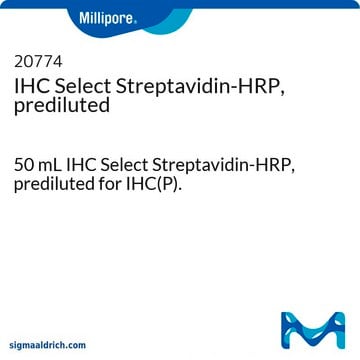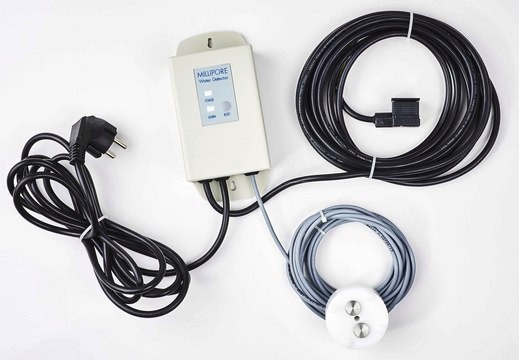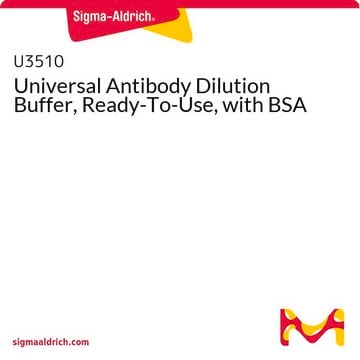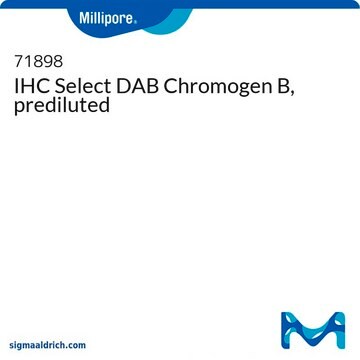DET-HP1000
IHC Select HRP Detection Set, (Blocking Reagent, Biotinylated linking Riagent and SA_HRP), Prediluted
IHC Select HRP Detection Set, (Blocking Reagent, Biotinylated linking Riagent & SA_HRP), Prediluted for Immunohistochemistry (Paraffin).
About This Item
Empfohlene Produkte
Speziesreaktivität
mouse, rabbit
Hersteller/Markenname
Chemicon®
IHC Select
Methode(n)
immunohistochemistry: suitable (paraffin)
Nachweisverfahren
colorimetric
Versandbedingung
wet ice
Allgemeine Beschreibung
The IHC Select Immunoperoxidase Secondary Detection System is intended for use with the CHEMICON IHC Select Prediluted Primary Antibody reagents, which contain rabbit and mouse IgG for the qualitative identification of antigens by light microscopy in paraffin-embedded tissues. The IHC Select Immunoperoxidase Secondary Detection System may also be used with other rabbit or mouse primary antibodies.
General Purpose Reagents
Principle of Procedure:
The IHC Select Immunoperoxidase Secondary Detection System uses biotin-avidin-HRP complexed antibodies to detect rabbit or mouse IgG in the Primary Antibody. The primary antibody binds to specific antigens present in the specimen. Any excess antibody is removed by washing. Next, the Secondary Antibodies Reagent (conjugated to biotin) is added and will react with the primary antibody present on the tissue. Unbound antibody is removed by washing. The sample is then by incubated with the Streptavidin-HRP solution, which binds to the biotin-labeled secondary antibody present on the tissue. Unbound enzyme is removed by washing. The chromogenic development reagent, 3,3′ diaminobenzidine (DAB Substrate), is then added and reacts with the HRP attached to the HRP-streptavidin-biotin-antibody complex. The HRP activity on the chromogenic substrate results in the deposit of brown to black insoluble precipitate at those antigenic sites containing the specific epitopes recognized by the primary antibody. Tissues processed in a variety of fixatives including neutral buffered formalin, B-5, and Bouin′s may be used.
Summary and Explanation:
Immunohistochemical techniques have been in use for the recognition of cells in tissue sections for at least 50 years. The first method reported use of fluorescent labels in 19411. In 1974, reports of using enzymatic labels, such as horseradish peroxidase (HRP) in routine H & E paraffin sections appeared2,3. The methods have since become the ′standard of care′ in surgical pathology when classic methods alone fail to yield a definitive diagnosis4-9.
Early techniques were based on the peroxidase-anti-peroxidase (PAP) reaction, while improvements exploited the strong affinity of avidin for biotin10. This technique uses HRP-labeled streptavidin. The secondary antibody is conjugated with biotin and the Strepavidin-HRP complex reacts with the biotin on the secondary antibodies. The resulting biotin-avidin-HRP complex can react with the primary antibody bound to the specific epitope of the target antigen. The HRP enzymes of the streptavidin complex then catalyze the substrate/chromogen reaction to form a coloured reaction product (brown to black when using DAB as the chromogen) at the antigen site. A biological stain (counterstain) is then used to visualize the tissue structure.
Verlinkung
Lagerung und Haltbarkeit
Precautions:
· Pooling, substitution or alteration of any reagent may cause erroneous results.
* Do not mix reagents from different lots.
* Do not allow the slides to dry at any time during the staining procedure.
* Handle all specimens and materials coming in contact with them as potentially infectious materials. Disinfect with 0.05% sodium hypochlorite.
* Do not mouth pipette reagents. If ingested, seek professional assistance or contact a Poison Control Centre immediately.
· Diaminobenzidine (DAB) may be carcinogenic. This solution may cause irritation upon skin contact. Avoid inhalation, ingestion, or skin contact and wear gloves when handling DAB. If skin contact occurs, flush affected area with water. Spills may be ′neutralized′ with bleach25,26. Dispose of according to local regulations.
· Inhalation or ingestion of xylene or the highly allergenic fixative formaldehyde is harmful. These materials should be handled with gloves. Prepare in a fume hood. If skin or eye contact occurs, wash thoroughly with copious amounts of water.
· Wear disposable gloves when handling any human material and while performing the staining procedure.
Rechtliche Hinweise
Haftungsausschluss
Signalwort
Warning
H-Sätze
Gefahreneinstufungen
Aquatic Chronic 2 - Eye Irrit. 2 - Skin Irrit. 2 - Skin Sens. 1
Lagerklassenschlüssel
12 - Non Combustible Liquids
Flammpunkt (°F)
Not applicable
Flammpunkt (°C)
Not applicable
Analysenzertifikate (COA)
Suchen Sie nach Analysenzertifikate (COA), indem Sie die Lot-/Chargennummer des Produkts eingeben. Lot- und Chargennummern sind auf dem Produktetikett hinter den Wörtern ‘Lot’ oder ‘Batch’ (Lot oder Charge) zu finden.
Besitzen Sie dieses Produkt bereits?
In der Dokumentenbibliothek finden Sie die Dokumentation zu den Produkten, die Sie kürzlich erworben haben.
Kunden haben sich ebenfalls angesehen
Unser Team von Wissenschaftlern verfügt über Erfahrung in allen Forschungsbereichen einschließlich Life Science, Materialwissenschaften, chemischer Synthese, Chromatographie, Analytik und vielen mehr..
Setzen Sie sich mit dem technischen Dienst in Verbindung.











